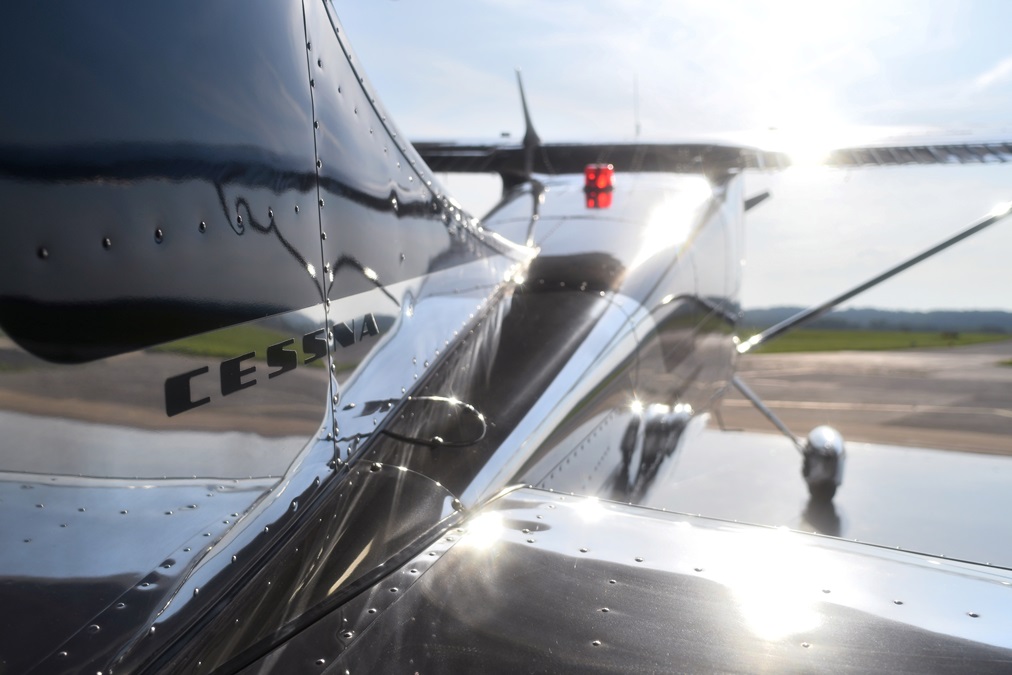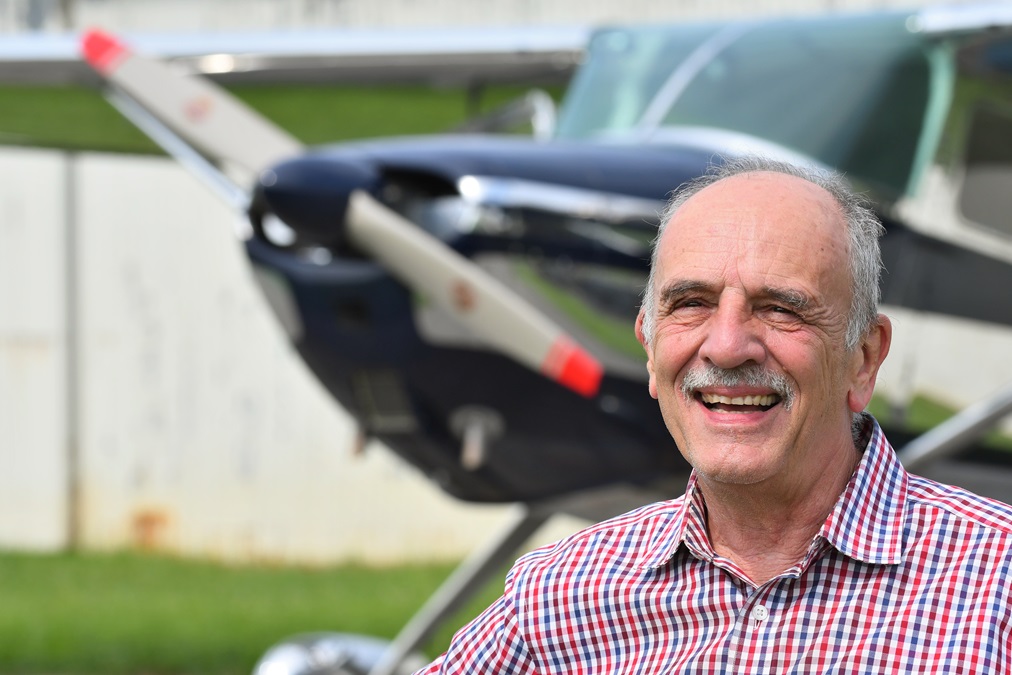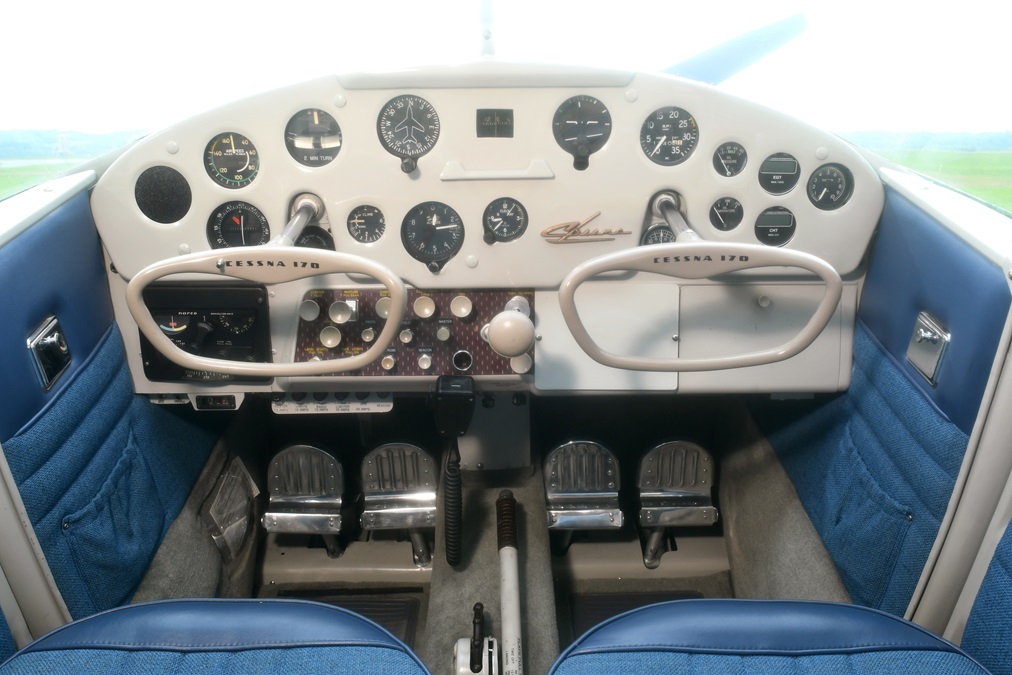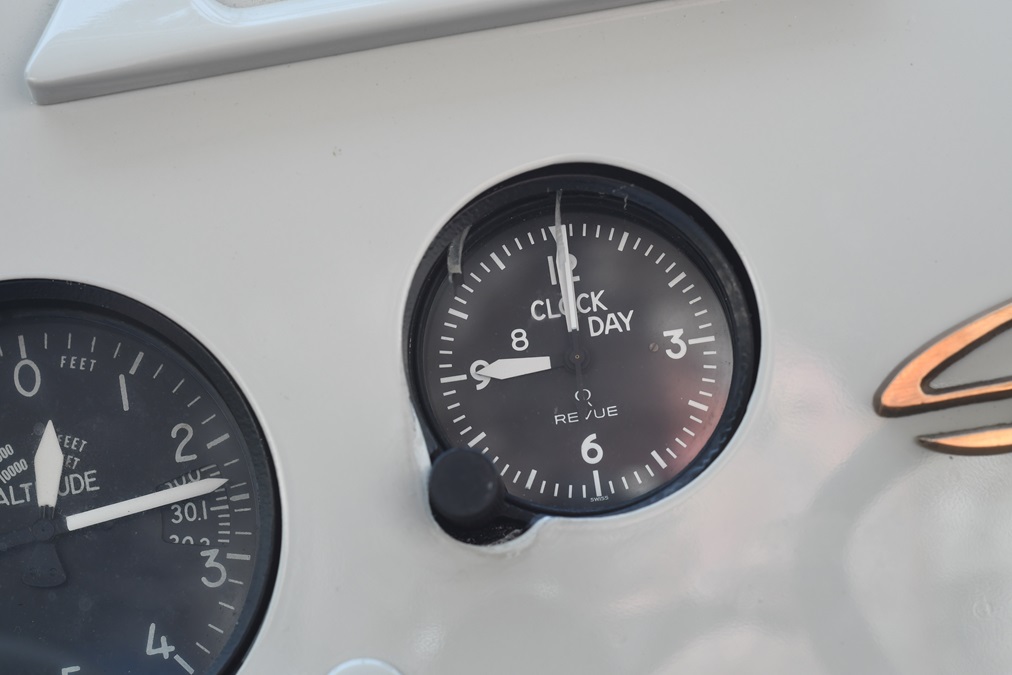Polish on, fly off
Keeping this classic Cessna shiny is a labor of love
The polisher isn’t that heavy, but the position is awkward and the aircraft’s owner appears uncomfortable. “I’ve tried all methods of getting to the wings,” he said. “Laying down on a scaffold, squatting on a four-foot ladder, but I always end up with the orbital over my head.”
Several times a year, Lalomia will spend two or three days polishing the immaculate 1954 Cessna—or “the bird,” as he and his wife, Karen Keltner, call their aircraft. “The ability to polish aluminum to this level is amazing. Once you get started, you really can’t stop,” he said.
Lalomia’s T-hangar at Orange County Airport in Montgomery, New York—in the southeastern part of the state, a few miles west of Stewart International Airport, the former Stewart Air Force Base—is about 60 miles north of New York City and typically a 90-minute drive from Lalomia’s Montclair, New Jersey, home. “To go fly, I have to drive 140 miles,” he said, defining the opportunity cost of a more affordable hangar. The hangar faces north, and on a clear day it offers a view of mountain peaks and clouds.
“Apply too much polish, and your face looks like spin art,” Lalomia laughed. “But when the light is just right in the afternoon and I pull the plane out when it’s gleaming, the T-hangar glows orange with the light, and the plane’s wings will be the bright blue of the sky.”
Then it might be time for a flight. Lalomia acknowledges that he spends more time with the orbital polisher in his hand than the Cessna’s yoke. “I have over 400 hours in polishing this plane in the first two years.” During that time, he flew the Cessna about 300 hours. “There’s no question about it—polish on, fly off.”
Lalomia didn’t start his search looking for a 170, however. “I always wanted to have a plane, and I wanted something kind of affordable,” he said, ruling out something new. “I’ve loved the lines of vintage aircraft. I love the looks of them.” Most vintage aircraft from the 1950s are “works of art,” he added.
He saved some money and spent two years looking around. “At one point I wanted a Falco. And then I was looking at Navions—I loved Navions.” Then, friends interested in classic aircraft introduced him to vintage Cessnas. “I got into the 120 and 140 look. A friend of mine had this [170] and he also has a polished 140 that’s an award-winner. He couldn’t take care of both of them.”
In 2011, Lalomia went up for a flight in the 170. “On takeoff I gave [the owner] a check. The plane flew great, and it had a new engine. The biggest concern for me was the engine.” He didn’t want to begin his ownership experience by having to write a check for $25,000 or more to pay for an engine overhaul. The airframe also was corrosion-free, his other major concern.
He is the Cessna’s fourth owner, and the aircraft was well cared for. “But it needed a new interior, and a few instruments didn’t work,” he said. “I started thinking, I want to make this look exactly like it was when it first came out of the factory.”
That launched a two-year restoration—and a lot of polishing—that earned him the Outstanding Cessna 170/180 award at EAA AirVenture 2013. Lalomia had no idea that he’d won when he arrived at the award ceremony. “We saw a picture of our plane on the video monitor and I said to my wife, ‘That’s a nice-looking Cessna. Wait, that’s ours!’
“That morphed into a deeper understanding of what this whole adventure’s going to be,” he continued. “It became about keeping it as a flying museum—it’s a beautiful flying replica of the era.”
Lalomia and Keltner love showing the airplane to people, and enjoy seeing their reactions. “With the polished aluminum, it draws people like flies. People love looking at the plane,” he said. “We feel a little like flying ambassadors, sometimes.” They display the 170 at many regional airshows—the Greenwood Lake Air Show, the National Warplane Museum’s Geneseo Airshow, the New York Air Show at Stewart International—and go to fly-ins on other weekends.
“That’s been a lot of fun,” Lalomia said. “People come up and say this is the most beautiful airplane they’ve seen in their life. I believe them—that’s pretty cool.” Sometimes a person will express an interest in learning to fly, and he tells them how to get started. He’s also flown about 25 Young Eagles for EAA Chapter 501.
At the 2017 AOPA Fly-In in Groton, Connecticut, an older gentleman walked up to the shiny 170. “After he saw the plane he said, ‘I don’t have to go any further. I can go home now,’” Lalomia recalled. “Some people come up to the plane and ask if I dipped it in chrome, which is funny. If they knew about aircraft, they’d know you couldn’t really do that. For me it’s very enjoyable to talk with anybody who has an interest. I think it’s because the plane is old, but it looks so new.”
Flying off
A typical trip for Lalomia and Keltner might be a local sightseeing flight, or to Block Island, Rhode Island, for breakfast. “We’ve flown to Oshkosh with the plane, and we’ve flown to North Carolina a couple of times,” he said. Lake Placid, New York, is a five-hour drive—or a one-hour, 15-minute flight.
And the aircraft is a good performer. “The plane flies really well. It’s very light on the controls,” Lalomia said. “The landing aspect, I love. The large Fowler flaps are very wide, and the plane comes down like a parachute the last 200 feet.” He found other Cessnas, such as the 182, to feel trucklike in comparison.
The 170 is happiest at 7,500 or 8,500 feet, burning eight and a half to nine gallons per hour and truing at 118 to 120 miles per hour. “I usually fly at an altitude where the wind is going to help us,” he added. “You don’t have to touch the wheel at all. She trims out really well. All you have to do is tap the rudders—we call it rudderpilot. You can fly 200 miles without touching the wheel.”
The couple finds the interior spacious, both front and back. “You could have a full, four-course meal in the back while you’re flying. There’s that much room.”
Rest of the story
The refurbishment went way beyond polishing the airframe. “I spent a lot of time researching, trying to get the interior exactly right for a 1954 Cessna 170,” Lalomia said. He worked with Airtex Products to replicate the original interior using modern, approved materials. “The guys in their shop were great. I went down there every week.” Airtex rebuilt the seats, using original drawings to match the pleating in blue leather. The company matched pleat lines on the door panels, as well.
Lalomia said it felt as if 50 pounds of wiring was removed from the airplane, including cables to the aft fuselage where the battery was originally located. He had all the original instruments restored except for the attitude indicator and vertical speed indicator, which he replaced with new ones that visually match the period. “We put sound insulation everywhere, which makes it a lot quieter,” he added.
The radios were repaired and the aircraft got a new alternator; strobes, for safety; and a four-place intercom. “We had to find room for the new circuit breakers. I didn’t want to litter the panel with them, so we put them in the glove box with the new intercom.” A metal panel hides the radios at shows, and an inoperative Narco Superhomer is just to the left of the pilot’s knee. Lalomia is especially proud of the restored aircraft clock. “It’s a wind-up, eight-day clock,” he said. “It’s not electric.”
Hard to stop
When he first bought the airplane, Lalomia lightly sanded the Alclad aluminum-coated, high-strength aluminum alloy. Now he polishes the airplane several times a year using the Nuvite system, basically three different grades of polish, and he’ll use Zephyr Pro 40 for a quick shine. “Phosphoric acid is the main ingredient in both. The better shine you get, the easier it is to buff it up,” he explained. Lalomia uses two-inch and six-inch orbital buffers, and Cyclo polishers. The process removes only the oxidation from the aluminum surface.
He and Keltner call the hangar their “aluminum hell,” and she often helps with the windshield and the painted portions of the airframe. “We have a 50-foot rule, a 20-foot rule, and a 10-foot rule,” Lalomia explained. “I get it to look good at 50 feet, then I get it to look good at 10 feet. At a certain point I stop.”
Solo, he might polish two or three straight days. “I usually polish it four times a year. One of those times, you have to take out all the screws and polish the holes. That’s the level of detail you get into,” he said. “If it weren’t for support from my beautiful wife, this wouldn’t happen. She’s really into the adventure, and that’s a great thing.”
Lalomia put some fans in the hangar to keep the air moving around, and he finds that helps to reduce oxidation. “If you wanted it perfect, you’d have to have humidity control. But that’s part of the joy of owning it.”
Changing the ratio
Lalomia has been “semi-working” for a few years and is contemplating retirement—and a move closer to the airport. “I think next year, I’ll be flying a lot more,” he said.
He and his wife want to go to events in Brodhead, Wisconsin, and at Triple Tree in South Carolina, among others. “There are lots of places we want to go, to stay involved with the vintage community,” Lalomia added. And although he is determined to shift the ratio to more flying and less polishing, N1936C appears destined to continue sporting that polished shine. “Sometimes you feel like this is crazy. Then you’re away from it for a few weeks and you say, ‘I have to go polish the plane,’” Lalomia confessed. “You’ve got to be kind of a nut to own these classic planes.”
Email [email protected]











